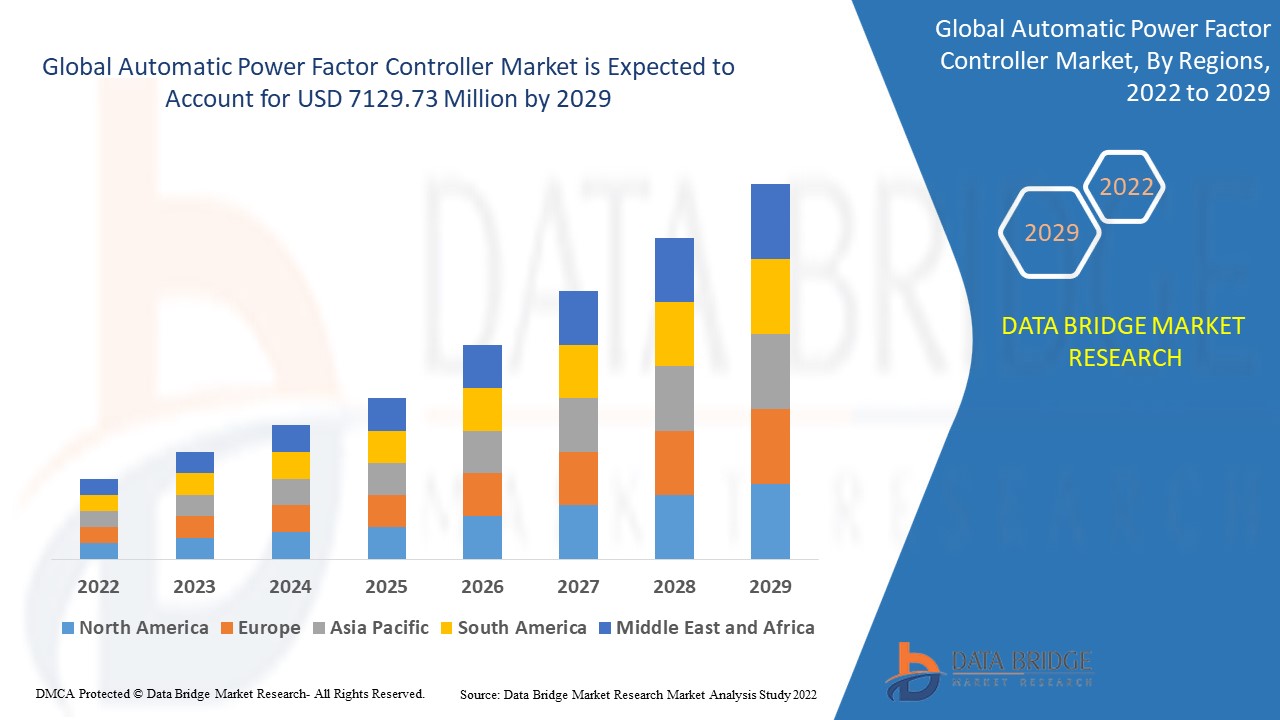Global Automatic Power Factor Controller Market
市场规模(十亿美元)
CAGR :
% 
 USD
5,013.52 Million
USD
7,129.73 Million
2021
2029
USD
5,013.52 Million
USD
7,129.73 Million
2021
2029
| 2022 –2029 | |
| USD 5,013.52 Million | |
| USD 7,129.73 Million | |
|
|
|
|
全球自动功率因数控制器市场,按类型(无源 APFC、有源 APFC)、组件(继电器、电容器、电阻器、显示器、微控制器、开关)、安装类型(独立式 APFC 面板、壁挂式 APFC 面板)、行业(制造业、公用事业、商业、企业、军事)划分 - 行业趋势和预测至 2029 年

市场分析和规模
预计全球自动功率因数控制器市场将在预测期内产生大量收入。市场大幅增长可归因于采用自动功率因数控制器来减少电力系统的损耗并维持功率因数。亚太地区一些可能引领全球自动功率因数控制器市场的发展中国家包括韩国、日本、印度和中国。因此,这些增长决定因素使市场在预测时间内前景乐观。
2021 年全球自动功率因数控制器市场价值为 50.1352 亿美元,预计到 2029 年将达到 71.2973 亿美元,在 2022-2029 年预测期内的复合年增长率为 4.50%。除了市场价值、增长率、细分市场、地理覆盖范围、市场参与者和市场情景等市场洞察外,Data Bridge 市场研究团队策划的市场报告还包括深入的专家分析、进出口分析、定价分析、生产消费分析和杵分析。
报告范围和市场细分
|
报告指标 |
细节 |
|
预测期 |
2022 至 2029 年 |
|
基准年 |
2021 |
|
历史岁月 |
2020(可定制为 2014 - 2019) |
|
定量单位 |
收入(百万美元)、销量(单位)、定价(美元) |
|
涵盖的领域 |
类型(无源 APFC、有源 APFC)、组件(继电器、电容器、电阻器、显示器、微控制器、开关)、安装类型(自立式 APFC 面板、壁挂式 APFC 面板)、行业(制造业、公用事业、商业、企业、军事) |
|
覆盖国家 |
美国、加拿大、墨西哥、巴西、阿根廷、南美洲其他地区、德国、法国、意大利、英国、比利时、西班牙、俄罗斯、土耳其、荷兰、瑞士、欧洲其他地区、日本、中国、印度、韩国、澳大利亚、新加坡、马来西亚、泰国、印度尼西亚、菲律宾、亚太其他地区、阿联酋、沙特阿拉伯、埃及、南非、以色列、中东和非洲其他地区 |
|
涵盖的市场参与者 |
通用电气(美国)、西门子(德国)、ABB(瑞士)、艾默生电气公司(美国)、AVEVA Group plc(英国)、施耐德电气(法国)、意法半导体(瑞士)、AB POWER SYSTEMS(印度)、Techno Power Systems(印度)、Semiconductor Components Industries, LLC(美国)、IBM(美国)、伊顿(爱尔兰)、(美国)、SAP SE(德国)、甲骨文(美国)、罗伯特·博世有限公司(德国)、德州仪器公司(美国)、Navitas Semiconductor Ltd.(美国)、富士通(日本)、ACPD Services Ltd(英国) |
|
市场机会 |
|
市场定义
自动功率因数控制器(也称为 APFC)基本上是一种可以自动改善、维持或纠正接近 1 的功率因数水平的工具。自动功率因数控制器可识别和纠正由电源电路中的连接电感负载引起的功率因数下降。
自动功率因数控制器市场动态
本节旨在了解市场驱动因素、优势、机遇、限制和挑战。以下内容将详细讨论所有这些内容:
驱动程序
- 终端行业需求蓬勃发展
各终端用户行业对自动功率因数控制器的需求不断增长,这是推动自动功率因数控制器市场增长的关键因素之一。该行业对电源管理设备的需求很高,预计这将推动全球自动功率因数控制器市场的发展。此外,自动功率因数控制器现在在商业、制造业、商业、军事和公用事业等领域得到更广泛的接受,这可能会加速预测期内全球市场的扩张。
- 自动功率因数控制器提供的众多好处
自动功率因数控制器市场受到其优势的积极影响,包括降低电价、节省电力和功率因数管理。由于该控制器能够保护电气设备,全球市场预计将快速增长。因此,自动功率因数控制器的这些优势进一步帮助市场在预测期内获得发展动力。
此外,快速工业化和城市化以及基础设施开发投资激增等因素将在预测期内加速整体市场扩张。此外,升级和复杂的基础设施的发展预计将推动自动功率因数控制器市场的增长率。工业设施的扩建以提高能源效率预计将在预测期内对市场增长率产生积极影响。
机会
- 投资和产品发布
制造商对改进和改进的投资不断增加,预计将为市场创造丰厚的机会,这将进一步扩大自动功率因数控制器市场的增长率。此外,市场参与者不断推出的产品和其他创新也为市场提供了大量增长机会。
限制/挑战
- 维护成本高
维护自主功率因数控制器的高成本是市场扩张的重大障碍。由于成本高昂,维修旧设备在经济上并不划算。开发和制造 APFC 面板的成本很高,因为它们需要大容量电容器和电感器来进行低频滤波。商业和工业设备价格昂贵,需要一次性投资。高昂的维护成本制约了全球自动功率因数控制器市场的发展。
- 功率因数控制器中的各种危害
安装功率因数控制器还存在一些其他危险。当连接到系统时,自动功率因数控制器会在其电容器和系统网络电感之间创建并联谐振电路。驱动器过压跳闸和过度电压失真只是波分量接近并联谐振放大时偶尔会导致的几个主要问题。电机、变压器和导体的绝缘击穿是另一个常见问题。这些危险可能会限制自动功率因数控制器的市场。
- 标准和监管要求
标准和监管要求将进一步阻碍整个市场的增长率。提高功率因数的标准和监管要求进一步导致设计复杂的电路。这些复杂的电路进一步需要大量的注意力和时间。因此,预计监管要求在预测期内对自动功率因数控制器市场来说将是一个重大挑战。
此外,过度的能源波动和真空接触器等替代品的可用性造成的技术限制也是阻碍市场整体增长的其他主要限制因素。
本自动功率因数控制器市场报告详细介绍了最新发展、贸易法规、进出口分析、生产分析、价值链优化、市场份额、国内和本地市场参与者的影响,分析了新兴收入领域的机会、市场法规的变化、战略市场增长分析、市场规模、类别市场增长、应用领域和主导地位、产品批准、产品发布、地域扩展、市场技术创新。如需了解有关自动功率因数控制器市场的更多信息,请联系 Data Bridge Market Research 获取分析师简报,我们的团队将帮助您做出明智的市场决策,实现市场增长。
COVID-19 对自动功率因数控制器市场的影响
自动功率因数控制器市场受到 COVID-19 爆发的巨大影响。此外,由于疫情对大多数人的总体经济状况产生了负面影响,人们越来越关心削减预算中不必要的开支,导致消费者需求下降。预计上述因素将在预测期内影响全球自动功率因数控制器市场的增长轨迹。随着各监管机构取消这些强加的封锁,全球自动功率因数控制器市场预计将反弹。
全球自动功率因数控制器市场范围
自动功率因数控制器市场根据类型、组件、安装类型和行业进行细分。这些细分市场之间的增长情况将帮助您分析行业中增长缓慢的细分市场,并为用户提供有价值的市场概览和市场洞察,帮助他们做出战略决策,确定核心市场应用。
类型
- 无源 APFC
- 主动式 APFC
成分
- 继电器
- 电容器
- 电阻器
- 显示器
- 微控制器
- 开关
安装类型
- 自立式 APFC 面板
- 壁挂式 APFC 面板
行业
- 制造业
- 公用事业
- 商业的
- 企业
- 军队
自动功率因数控制器市场区域分析/见解
对自动功率因数控制器市场进行了分析,并按上述国家、类型、组件、安装类型和行业提供了市场规模洞察和趋势。
自动功率因数控制器市场报告涵盖的国家包括北美的美国、加拿大和墨西哥、欧洲的德国、法国、英国、荷兰、瑞士、比利时、俄罗斯、意大利、西班牙、土耳其、欧洲其他地区、亚太地区的中国、日本、印度、韩国、新加坡、马来西亚、澳大利亚、泰国、印度尼西亚、菲律宾、亚太地区的亚太地区其他地区、沙特阿拉伯、阿联酋、以色列、埃及、南非、中东和非洲其他地区、巴西、阿根廷和南美洲其他地区。
北美在自动功率因数控制器市场占据主导地位,因为在 2022 年至 2029 年的预测期内,该地区存在主要的市场参与者。此外,预计在预测期内,工业设施的扩建将提高能源效率并加速扩张。
由于亚太地区基础设施的先进发展,预计该地区在 2022 年至 2029 年的预测期内将出现显着增长。此外,快速城市化和工业化等因素也在推动区域市场的扩张。
报告的国家部分还提供了影响单个市场因素和国内市场监管变化,这些因素和变化会影响市场的当前和未来趋势。下游和上游价值链分析、技术趋势和波特五力分析、案例研究等数据点是用于预测单个国家市场情景的一些指标。此外,在提供国家数据的预测分析时,还考虑了全球品牌的存在和可用性以及它们因来自本地和国内品牌的大量或稀缺竞争而面临的挑战、国内关税和贸易路线的影响。
竞争格局和自动功率因数控制器市场份额分析
自动功率因数控制器市场竞争格局提供了按竞争对手划分的详细信息。详细信息包括公司概况、公司财务状况、产生的收入、市场潜力、研发投资、新市场计划、全球影响力、生产基地和设施、生产能力、公司优势和劣势、产品发布、产品宽度和广度、应用主导地位。以上提供的数据点仅与公司对自动功率因数控制器市场的关注有关。
自动功率因数控制器市场的一些主要参与者包括
- 通用电气(美国)
- 西门子(德国)
- ABB(瑞士)
- 艾默生电气公司(美国)
- AVEVA Group plc(英国)
- 施耐德电气(法国)
- 意法半导体(瑞士)
- AB POWER SYSTEMS(印度)
- Techno Power Systems(印度)
- 半导体元件工业有限公司 (美国)
- IBM(美国)
- 伊顿(爱尔兰)
- SAP SE(德国)
- 甲骨文 (美国)
- 罗伯特·博世有限公司 (德国)
- 德州仪器公司。(美国)
- 纳维半导体有限公司(美国)
- 富士通(日本)
- ACPD 服务有限公司 (英国)
SKU-
Get online access to the report on the World's First Market Intelligence Cloud
- Interactive Data Analysis Dashboard
- Company Analysis Dashboard for high growth potential opportunities
- Research Analyst Access for customization & queries
- Competitor Analysis with Interactive dashboard
- Latest News, Updates & Trend analysis
- Harness the Power of Benchmark Analysis for Comprehensive Competitor Tracking
研究方法
数据收集和基准年分析是使用具有大样本量的数据收集模块完成的。该阶段包括通过各种来源和策略获取市场信息或相关数据。它包括提前检查和规划从过去获得的所有数据。它同样包括检查不同信息源中出现的信息不一致。使用市场统计和连贯模型分析和估计市场数据。此外,市场份额分析和关键趋势分析是市场报告中的主要成功因素。要了解更多信息,请请求分析师致电或下拉您的询问。
DBMR 研究团队使用的关键研究方法是数据三角测量,其中包括数据挖掘、数据变量对市场影响的分析和主要(行业专家)验证。数据模型包括供应商定位网格、市场时间线分析、市场概览和指南、公司定位网格、专利分析、定价分析、公司市场份额分析、测量标准、全球与区域和供应商份额分析。要了解有关研究方法的更多信息,请向我们的行业专家咨询。
可定制
Data Bridge Market Research 是高级形成性研究领域的领导者。我们为向现有和新客户提供符合其目标的数据和分析而感到自豪。报告可定制,包括目标品牌的价格趋势分析、了解其他国家的市场(索取国家列表)、临床试验结果数据、文献综述、翻新市场和产品基础分析。目标竞争对手的市场分析可以从基于技术的分析到市场组合策略进行分析。我们可以按照您所需的格式和数据样式添加您需要的任意数量的竞争对手数据。我们的分析师团队还可以为您提供原始 Excel 文件数据透视表(事实手册)中的数据,或者可以帮助您根据报告中的数据集创建演示文稿。













